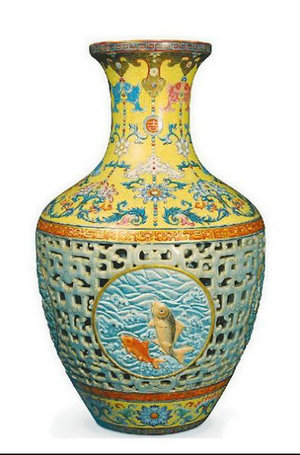Extended Reading: More High-priced Porcelains
Qianlong vase sets record for Chinese art at regional auction house
 |
|
|
A Qianlong period (c.1740) Imperial yang cai reticulated double-walled vase with six-character reign mark has became the most expensive Chinese work of art ever to sell at auction anywhere in the world. It sold for £51.6m ($83m) at Bainbridge’s Auctions, in the west London suburb of Ruislip, to an anonymous Chinese buyer in the room. It is not yet known whether he represented a mainland Chinese institution or private buyer. The price beat the previous record of RMB436.8m ($65.95m) set at Beijing Poly in June 2010 for a Song Dynasty scroll by Huang Tingjian (1045-1105).
The vase was discovered during a routine valuation at a house in the London satellite town of Pinner. Its owners had inherited it from a relative, who they believe acquired it in the 1930s. “They had no idea what it was, but we could see that it was good—we gradually realized how special it was when our expert cataloguer began to do some research”, said Jane Bainbridge, co-partner in the auction house.
The estimate was set at £800,000-£1.2m, but rumours began to circulate that it could reach the £15m mark after an advert was posted in the British trade newspaper Antiques Trade Gazette two weeks ago. It was timed to tie in with the annual Asian Art in London sales and exhibitions. “People began to phone us up from all over the world after that”, said Bainbridge.
The auction room was full, with many Chinese buyers in attendance and more on the telephones. As the price climbed to £15m the auctioneers stayed calm as the increments continued to rise. “We all behaved exactly as we do at any sale, but the room got very excited—we had a round of applause when bidding reached the £40 million mark”.
The term yang cai translates as “foreign colours” and refers to the palette of enamels that were introduced from Europe around 1685, and later became associated with the famille rose export wares.
The 16-inch (40.5cm) high vase is of ovoid form with celadon glazed pierced body of interlocking chilong, through which could be seen the inner body of Ming style blue and white scrolling flowers. Four medallions around the body are decorated with varied pairs of fish set against modelled and carved waves.





Why not rent a boyfriend, or girlfriend to please parents during the Spring Festival?